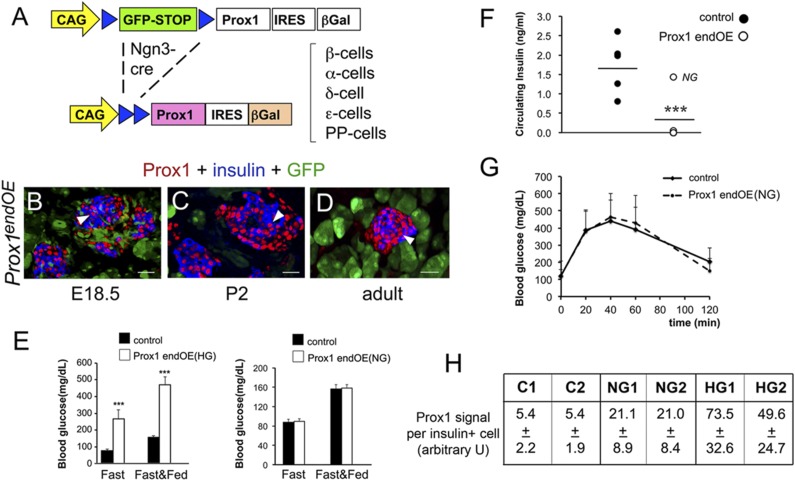Figure 2.
Prox1 overexpression in immature β-cells causes hyperglycemia and hypoinsulinemia. A: Neurog3-Cre deleted a GFP-STOP cassette and activated exogenous expression of both Prox1 and β-gal in endocrine precursors and islet cells of Prox1endOE mice. Insulin+ cells (blue) of Prox1endOE mice expressed high levels of Prox1 (red and arrowheads) at embryonic (B), newborn (C), and adult (D) stages. Note that the islet cells are GFP− and the surrounding nonislet cells are GFP+. E: Prox1endOE(HG) mice showed hyperglycemia under fed (Fast&Fed) and fasting (Fast) conditions (control, Neurog3-Cre mice; n = 15–20 mice per genotype). In contrast, Prox1endOE(NG) mice and control mice (Neurog3-Cre) had similar glucose levels under fed and fasting conditions (n = 4–5 mice per genotype). F: Blood insulin levels were significantly lower in Prox1endOE(HG) mice than in control mice (Neurog3-Cre). A single mouse in the Prox1endOE group classified as normoglycemic (NG) showed blood insulin levels comparable to those of control mice (n = 5 mice per genotype). G: Prox1endOE(NG) mice and control mice (Neurog3-Cre) had similar glucose clearance after intraperitoneal glucose tolerance test (n = 9–12 mice per genotype). H: Prox1 immunofluorescence in single insulin+ cells was about fourfold higher in normoglycemic pancreata (NG, n = 2) and 9- to 13-fold higher in hyperglycemic pancreata (HG, n = 2), compared with controls (C, n = 2). Error bars represent +SEM values. ***P < 0.001. B–D are confocal images. Scale bars: 25 μm.

